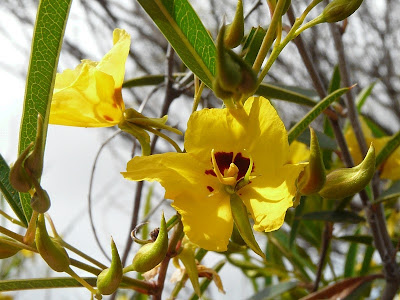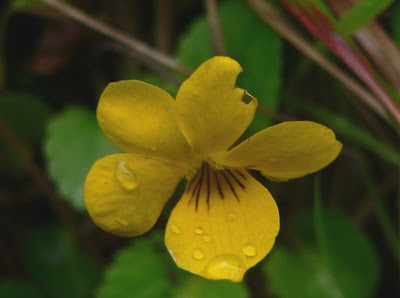This is another in a periodic series on colours in nature, though it's now a while since I promised to wrap up the mini-series on yellow with a posting on yellow flowers. It seems that not a lot of work has been done on flower pigments (compared with pigments in fruits and vegetables for instance) but it seems agreed that flavonoids are the most important class of yellow-causing pigments in flowers. Yellow is a good colour for insects - they see better at the blue-yellow end of the visible spectrum than at the red end. Today however I just want to have a bit of fun, and parade some of my favourite yellow flowers, beginning with A and ending with Z!
My intention was to keep it simple, and to show a yellow-flowering species from one genus for every letter of the alphabet. It almost worked too. Y was never a starter, as there is no Y in Latin; other than that the two letters I couldn't come up with anything for were Q, perhaps unsurprisingly, and K, a little more surprising. Lastly, and surprisingly, I failed on F too, though here at least I could offer you a species name instead! Enough blathering, let's start the journey.
A
+TdPNP+1107.jpg) |
| Alstroemeria patagonica, in the cold and windy Torres del Paine NP, Chilean Patagonia. The family, Alstroemeriaceae, is limited to South America. |
B
| Bossiaea foliosa, Buccleuch State Forest, west of Canberra. This lovely pea shrub lights up the entire Snow Gum understorey in early summer in a good season. |
C
D
 |
| Dillwynia sericea, Silky Parrot Pea, Canberra A common and distinctive shrub in the dry forests that are my 'back yard'. |
E
 |
| Eremophila maculata, south-west Queensland. Family Myoporaceae (or Scrophulariaceae). A yellow form of a generally red flowering shrub, widespread in inland Australia. |
F
G
 |
| Gavilea lutea, Torres del P aine NP, Chile. A spectacular big orchid from grassy areas of the far south of South America. |
I
 |
| Isopogon anethifolius, Bundanoon, New South Wales. Family Proteaceae. An important component, as a genus, of sandy and sandstone heathlands in south-west and south-east Australia. |
J
L
+Kalbarri+0808.jpg) |
| Labichea lanceolata, Kalbarri NP, Western Australia. Family Caesalpinaceae. An endemic genus of 14 species found across inland northern Australia. |
M
| Microseris lanceolata, Canberra. A widespread, but now uncommon, species of daisy, whose story I told here last yeat. |
N
 |
| Nuytsia floribunda, Western Australian Christmas Tree, Cape le Grande National Park, family Loranthaceae. A mistletoe that grows as a tree, drawing water and nutrients from the roots of nearby plants. |
 |
| Odontoglossum mystacimum, Manu National Park cloud forest, Peru. A huge orchid genus, with some truly spectacular species; this is one of my favourites, growing at 4000 metres above sea level. |
P
 |
| Podolepis jaceoides, Namadgi National Park near Canberra. I love the 'frayed ends' of the ray florets of these big high country daisies. |
 | |
| Ranunculus sp., Tallong, New South Wales. The surface cell structure of these buttercups acts as a mirror to attract pollinating insects. |
S
 |
| Senna coriacea, Caralue Bluff Conservation Park, South Australia. Family Caesalpinaceae. The sennas are found throughout inland Australia, brightening entire landscapes sometimes. |
U
 |
| Utrichularia odorata, Fogg Dam near Darwin, Northern Territory. Family Lentibulariaceae. The bladderworts grow in water, trapping tiny animals in senstive 'bags' on the roots. |
 |
| Viola maculata, Chilean Patagonia. Was it so unreasonable to expect that violets should be violet - even in South America? Apparently yes. |
W
 | |
| Waitzia nitida, Kalbarri NP, Western Australia. An attractive widespread group of about five dryland Australian paper daisies. |
 |
| Xyris operculata, Morton National Park, New South Wales. An enormous genus of wetland plants found mostly in northern South America. (I bet you didn't think I coud do an X...) |
Meantime though, I hope you've had fun, thanks for coming along.
BACK ON MONDAY



